GST
was rolled out in India to change the circuitous tax assessment
framework. Further, GST was introduced with a slogan of One Nation One
Tax to ease the compliance procedure. In this article, we survey a
portion of the significant focal points of GST execution in India for
startups and small businesses in India.
GST Overview
Goods
and Services (GST) is a destination based value-added tax, collected at
all focuses on the production network with taking inputs into
consideration. Along these lines, it is the end customer who bears the
GST as the last individual in the production network. The presentation
of GST in India is relied upon to result in real rearrangements of
aberrant assessment structure at both Center and State levels -
supplanting the various layers of complex tax assessment right now
existing in India.
No Late Fee for GSTR-1 and GSTR-3B Return
31st
GST Council provided the greatest help stretched out to startup and
small businesses by waving off of late fees on GSTR-1 and GSTR-3B
return. The GST Council has declared:
Therefore, filing GSTR-1, GSTR-3B and GSTR-4 until 31st March 2019 did not draw in any late fee.
GST Annual Return Due Date Extended
Every entity under GST is required to document annual GST Return in GSTR-9 form. Generally, 31ST December
of every calendar year is the due date for filing GSTR 9 (GST Annual
Return) for the financial year of that particular calendar year. As GST
is recently introduced in India, the Government and GST authority has
chosen to expand the due date for filing GSTR 9 (Annual GST Return) to
30th June 2019. However, the due date for GSTR 9 was initially extended
up to 31st March 2019 but GST council has additionally stretched out
this date of filing to 30th June 2019.
Ease of Starting a Business in India under GST
With
the execution of GST in India, the method for registration of GST would
be standardized and centralized similar to registration under service
tax. Under GST routine, business would never again need to acquire
various VAT registrations- as a solitary GST registration would be
appropriate all over India. The system for acquiring GST registration
would likewise be centralized, consequently improving the simplicity of
beginning another business in India.

Practical challenges
While
the GST authorities have introduced many changes in the GST laws but,
on the contrary, the floor-level realities are very distinct. And this
has offered extra opportunities to the new business model for improving
business avenues. Other benefits below this aspect are:
- Reduction in time for transportation of goods
- Storage and transportation cost reduction
- The supply chain is anticipated to be the sole function of requirements of business
- Development of warehousing hubs which can be organized and towards dense client geographies
One
India One tax is predicted to yield huge advantages and possibilities
for startups, specifically in the e-commerce operator and logistics
sector.
Subsuming Multiple Taxes in GST
Under
the GST regime, a significant number of the taxes are subsumed and made
into one tax. The following tax will be subsumed under GST:
Central Taxes subsumed under GST
- Central Excise Duty (counting extra extract obligations)
- Service charge
- Additional traditions obligation (CVD)
- Special Additional Duty of Customs (SAD)
- Central additional charges and cesses
State Taxes subsumed under GST
- Value Added Tax (VAT)
- Central Sales Tax (CST)
- Octroi and Entry Tax
- Purchase Tax
- Luxury Tax
- Taxes on lottery, wagering and betting
- State cesses and additional Taxes
- Entertainment Taxes
GST Exemption for Startups and Small Businesses
Under
GST Regime, organizations with a turnover of under Rs.40 lakhs per
annum would not need not to take registration under GST. Accordingly,
many startups and small business having an annual turnover of Rs.5 lakh -
Rs.40 lakh would be out of the assessment. This will help them to grow
as they need not file GST Returns.
Simplification of Compliance Procedure under GSTPreviously,
businesses such as computer dealers, restaurant- which sells
merchandise and gives benefits as a bundle needs to comply with both VAT
and Service Tax guidelines. The businesses need to figure out taxes on
the supply as different rates were applicable for different products.
With the presentation of GST, the differentiation between Goods and
Services has been refined - in this way making compliance procedure
under GST simpler. Further, invoicing is simpler for organizations as
just a single rate has to be embraced.


I have read out your blog on Startup Accounting and compliance. Well written. Thanks for sharing
ReplyDelete